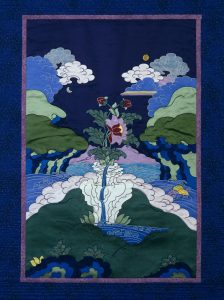So many of you made such wonderful comments on my latest work, “Beauty,” when I posted it on Facebook and on this blog two weeks ago. I’m just putting the finishing touches on the borders now and will attach a sleeve at the back for hanging.
Today, I wanted to give you some background on this piece.
It was commissioned by an American woman who has lived for many years in Milan, Italy. We met last year at a Democrats Abroad dinner and later she attended my Mosaici di Seta exhibition at the Centro Mindfulness Project in Milan. We developed a warm personal connection and she appreciated the colors, textures, and spiritual depth of my work (Correct me if I’m wrong, Sharon!). She liked the idea of commissioning artwork from an artist with whom she felt a personal connection and with whose story she resonated.
She was drawn to the traditional designs but, not being Buddhist, did not feel a connection with the traditional deities. Together, we decided on a landscape piece similar to one I’d done during my apprenticeship:

Untitled thangka without eyes, © 1995 Leslie Rinchen-Wongmo
This drawing has an interesting story. While apprenticing to T.G.Dorjee Wangdue in Dharamsala, I learned the techniques of making colored cords, couching them to the silk, cutting and folding pieces of a design and stitching clusters of pieces together. Gen la (Tibetan for teacher) drew all the lines on the cloth and assembled our stitched pieces, using a drawing prepared by a thangka-painting master as a guide. With the intention to become autonomous in making my own thangkas, I watched closely as he transferred bits of the drawing to cloth and as he assembled clusters of pieces. For hands-on practice, I needed to work on my own in off hours.
At this point, I had not yet learned to embroider eyes. Later in my apprenticeship, I would learn the unique spiral embroidery technique and would spend a year making only eyes.
But at this point (in 1995, I believe) in order to create and assemble my own fabric thangka from start to finish, I needed a design without eyes. I asked my friend, thangka painter Alex Kocharov, to draw me a template for a thangka without eyes. He wasn’t sure he liked the idea but, fortunately for me, he complied and produced an elegant drawing of a traditional Tibetan style landscape with a graceful lotus flower rising from a vase of rocky crags. The flower in this scene feels to me like an essential manifestation of all the deities, with their dignity and ease.
My first realization of this design was produced from the cotton fabrics and threads I could find in the Dharamsala market, Kotwali Bazaar. The result is rough and somewhat primitive but powerful nonetheless.
The newer incarnation is made mostly of silks, some purchased from Varanasi, others hand-dyed by me. Gold-tinged Varanasi brocade forms the leaves. As with most of my work, the elements of the picture area are all hand stitched and machine sewing is only used in creating the frame This image is framed with quilted cotton borders, completing the special blend of traditional and contemporary in this one-of-a-kind thangka without eyes.

“Beauty” by Leslie Rinchen-Wongmo, 2009


Hi – came over from Twitter and UYB…your work is well, I can’t think of a good enough word: splendiferous? awesome? amazing? something with all those wrapped up together? I have a girlfriend who loves Tibetan work who I’m going to send right over (she’s at http://www.mysticaldreamart.com – you might like her work too). Am looking forward to working with you during the Christine Kane program!
Just curious – how long does it take to make one of these (and one year on eyes! how many years have you studied?)
Thanks Tammy!
My apprenticeship lasted about four years (about 30 hours per week if I recall correctly), of which one year was spent just on eyes. I completed the apprenticeship in 1997, but I continue to learn. It takes me about four months of consistent work to make a typical silk thangka. This piece took a bit more than two months. Some highly detailed works can take even longer.
Looking forward to exchanging ideas with you!
my love for thangkas found an awesome site -https://threadsofawakening.com/?p=692